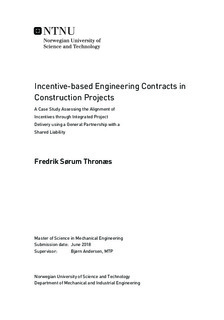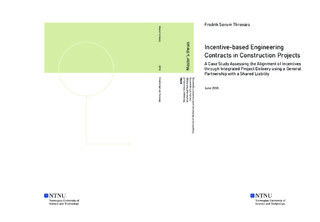| dc.description.abstract | This thesis provides research on the contract strategy in construction projects, the effect of more integrated project delivery on the design phase of construction projects and more specifically the contract types that are used to compensate consultants providing engineering work in construction projects and their incentives. Building on a previous specialization project, this thesis aims to put some of the theory in context by analysing a case study which uses one approach of integrated project delivery. The purpose is to see whether such an approach to more integrated project delivery systems can help align the incentives in the contracts used towards consultants providing engineering work in the design phase of construction projects.
The thesis contains an extensive theoretical framework based on literature studies, where the contract strategy, contract designs and contract types used in construction projects are described. Furthermore, the theoretical framework describes some theory on incentives, including the principal-agent problem, transaction cost theory and their effect on construction contracts, relational contracting and integrated project delivery. Additionally, a case study involving an industrial housing project where the main-contractor consists of a general partnership with a shared liability is analysed. The general partnership integrates the contractors and consultants into one entity and uses a pool of shared gains/losses in conjunction with cost reimbursable contracts with upper price ceilings to compensate the partners. Five interviews with different consultants within this general partnership were conducted to provide qualitative data and give a practical perspective to the theory.
The study shows that the integration of the consultants and the contractor into one entity facilitates early integration in the design phase of the projects which allows for interdisciplinary collaboration and leads to innovative and rational solutions. The case project estimates a reduction in the construction costs by 20%, while maintaining the quality of the delivery. The interviews suggest that the shared gains/losses fail to provide sufficient alignment of the financial incentives in the cost reimbursable contracts. However, the overall collaboration clearly provides semi- and non-financial incentives which proves to make a substantial impact on the motivation and inspiration of the consultants. The thesis also indicates that the semi- and non-financial incentives may be underrated in the contractual context. The general partnership with a shared liability fits with what the literature describes as an IPD-ish -contract and follows many of the principles of integrated project delivery but fails to include the project owner in the collaboration. The ideal contract type for the consultants is the cost reimbursable contract without any price ceiling. Such a contract type would be practically impossible to implement because of the inherent misaligned incentives and thus provides too high a risk for the principal. However, integrated project delivery methods in various forms in addition to financial incentive schemas like the shared gains/losses with an adequate incentive intensity can help align these misaligned incentives in this contract type which might be a step towards the contract for the future. | |

